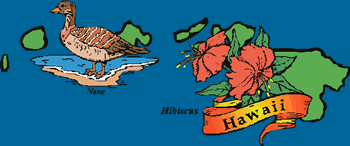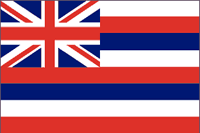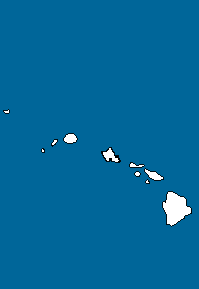 History:
Captain James Cook of the British navy was the first European to discover the Hawaiian Islands. He landed there on January 18, 1778 and was received warmly by the Hawaiians. Cook named these Islands the Sandwich Islands in honor of the Earl of Sandwich, the first lord of the British admiralty.
After Cook's discovery, other traders and explorers began sailing to the islands. These visitors from Europe and America traded livestock, plants, and manufactured goods from other parts of world with the Hawaiians for the islands' highly valued sandalwood.
During this period of time, the islands were under the rule of local warring chiefs. King Kamehameha I united the islands and became their ruling chief in 1810. A time of peace followed, during which agriculture and commerce flourished. But problems began to develop. Visitors to the islands had brought with them many infectious diseases that sickened and killed large numbers of native Hawaiians. Cultural traditions began a steady decline as Western ways were introduced. Even the native Hawaiian religion, characterized by idol worship and the belief in many gods and goddesses, began to break down. King Kamehameha II abolished these religious practices in 1819 shortly after assuming the throne. A period of religious unrest followed.
When Hiram Bingham came to Hawaii in 1820 with his group of Protestant missionaries, he found a much less idyllic culture than that originally discovered by Captain Cook. Bingham and his missionaries set up schools, established the Hawaiian alphabet, and translated the Bible into the Hawaiian language. Protestantism became the official religion. Roman Catholic priests and missionaries were forced out of the islands, and many Hawaiians who had converted to Catholicism were imprisoned. Religious freedom was eventually established 1839 under the rule of King Kamehameha III.
A constitutional monarchy was established in 1840. It included a supreme court and a legislature made up of a council of chiefs and a house of representatives The United States formally recognized Hawaii as an independent government in 1842.
Until 1848, all land in Hawaii was owned by the King. Various areas were granted or leased to chiefs or people from other countries. This feudal land practice was abolished with a law known as the Great Mahele (Great Division). All of Hawaii's land was divided between King Kamehameha III and the chiefs, who subsequently gave most of it to the government. Individual Hawaiians began to buy this land and private ownership was established.
The sugar industry was founded in Hawaii in the 1830s. Large sugar cane plantations required many workers and there were not enough native Hawaiians to provide the labor. During reigns of Kamehameha IV and V (1854-1872), plantation owners began to bring workers from China, Polynesia, and Japan. Hawaiian sugar became an important commodity in trade with the United States.
When King Kalakaua came to the throne in 1874, he revived the traditional Hawaiian culture. The Christian missionaries who came to the islands in the early 19th century had prohibited native music and dancing. Under Kalakaua's reign, these customs were revived. Under the King's leadership, the sugar-cane industry grew, the pineapple industry was established with plants imported from Jamaica, and the United States was granted exclusive rights to establish a naval base at Pearl Harbor (1887) in exchange for certain trading privileges.
When Kalakaua died in 1891, his sister Liliuokalani began her rule. But a desire for a more stable government and for constitutional reform led to a revolution that removed her from power in 1893. A provisional government was established and the Republic of Hawaii was formed in 1894. Sanford B. Dole served as its president.
In 1898, with pressure from the sugar plantation owners, President McKinley agreed to annex Hawaii as a possession. The islands became a U.S. territory in 1900 and all Hawaiians were granted American citizenship but as territorial citizens, they could not vote in presidential elections. Dole became the territory's first governor.
Although statehood for Hawaii was proposed many times, Congress repeatedly rejected the idea. There were concerns about the territory's distance from the mainland and its mixed population.
On December 7, 1941, a surprise attack on Pearl Harbor brought the United States abruptly into World War II. The Hawaiian Islands became the primary Pacific military base for United States forces during the war and the territory was placed under martial law from 1941 and 1943.
After the war, Hawaii experienced great economic growth. Workers on plantations and along the waterfront organized under the International Longshoremen's and Warehousemen's Union. The tourist industry, already significant to the territory's economy, expanded with advances in air travel. Luxury hotels, resorts, and housing developments were constructed.
Movement toward statehood progressed rapidly. Hawaii was finally admitted to the union as the 50th state on August 21, 1959. |









